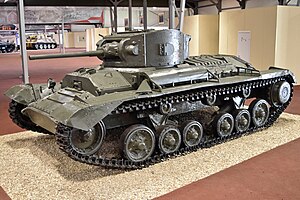| Tank, Infantry, Valentine, Mk I–XI | |
|---|---|
 Valentine II at Patriot Park, Russia | |
| Type | Infantry tank |
| Place of origin | United Kingdom |
| Service history | |
| In service | 1940–1960 |
| Used by | British Army, Red Army, New Zealand Army |
| Wars | World War II 1948 Arab–Israeli War Cyprus crisis of 1963–64 |
| Production history | |
| Designer | Vickers-Armstrongs |
| Designed | 1938 |
| Manufacturer | Vickers-Armstrongs and others |
| Produced | 1940–1944 |
| No. built | 8,275 (6,855 built in UK and 1,420 in Canada) |
| Specifications | |
| Mass | about 16 long tons (16 t) |
| Length | hull: 17 ft 9 in (5.41 m) |
| Width | 8 ft 7.5 in (2.629 m) |
| Height | 7 ft 5.5 in (2.273 m) |
| Crew | Mk I, II, IV, VI–XI: 3 (Commander, gunner, driver) Mk III, V: 4 (+ loader) |
| Armour | 0.31–2.56 in (8–65 mm) |
Main armament | Mk I–VII: QF 2-pounder (40 mm) Mk VIII–X: QF 6-pounder (57 mm) Mk XI: QF 75 mm Mk IIICS QF 3-inch (76 mm) |
Secondary armament | Mk I–VII, X, XI: 7.92 mm BESA machine-gun with 3,150 rounds |
| Engine | Mk I: AEC A189 9.6 litre petrol Mk II, III, VI: AEC A190 diesel Mk IV, V, VII–XI: GMC 6004 diesel 131–210 hp (97–157 kW) |
| Power/weight | 12.4 hp (9.2 kW) / tonne |
| Transmission | Meadows Type 22 (5 speed and reverse) |
| Suspension | modified three-wheel Horstmann suspension "Slow Motion" |
| Fuel capacity | 36 gallons internal |
Operational range | 90 mi (140 km) on roads |
| Maximum speed | 15 mph (24 km/h) on roads |
Steering system | clutch and brake |
The Tank, Infantry, Mk III, Valentine was an infantry tank produced in the United Kingdom during World War II. More than 8,000 Valentines were produced in eleven marks, plus specialised variants, accounting for about a quarter of wartime British tank production.[1] The variants included riveted and welded construction, petrol and diesel engines and increases in armament. It was supplied in large numbers to the USSR and built under licence in Canada. It was used by the British in the North African campaign. Developed by Vickers, it proved to be strong and reliable.[1][2]
- ^ a b Forty 2006, p. 98.
- ^ The Tank Museum (24 November 2015). "Tank Chats #11 Valentine | The Tank Museum". YouTube. Retrieved 6 December 2020.